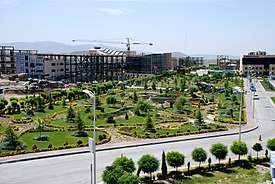Pardis Technology Park

Coordinates: 35°43′43″N 51°49′33″E / 35.72861°N 51.82583°E
Pardis Technology Park (PTP) (Persian: پارکِ فناوریِ پردیس) is a technology park, based in Pardis, a satellite city 20 kilometres (12 mi) outside of the Tehran metropolitan area, in Iran.[1] The park has been proclaimed the "Silicon Valley of Iran".
The park is located adjacent to a Telecommunication Company of Iran Satellite Earth Station, at the foot of the Alborz mountains. Land has been allocated here to promote the establishment of businesses related to technology. The site enjoys a panoramic view of the tallest mountain in Iran, Mount Damavand.
Pardis Technology Park (PTP), as the region's technology paradise, is located in a 38 hectares area (expandable to 1000 hectares) at 25 km northeast vicinity of Tehran. It has been cited as a booming private industry marvel, under the supervision of the Presidency and a 14-entity Board of Trustees from ministries, science centers, and academies.
As of 2011, approximately 75 companies have signed contracts for land at the park.[2] 37 of them have finished construction of their R&D centers. Out of those, 23 companies are actively running their activities located in the park. With accounting companies doing their business in rental flats, PTP has more than 51 companies located in Multi-Tenant Building and Business Incubator Center. In total, PTP has 123 hi-tech companies as its members in different establishment categories (Lands, Multi-Tenant Building and Business Incubator). As of 2012, 80% of investments in the park came from the private sector, and 150 new technologies have been developed and registered there.[3] As of 2013, a number of Iranian companies have transferred their R&D departments to PTP.
Objectives
The park describes its objectives as:[4]
- To intensify high-tech industries development.
- To promote cooperation between industries academic institutions and research centers.
- To create synergy between private and state sectors.
- To commercialize know-how and innovations generated by research centers.
- To promote research and development activities in private sector.
Services
- Information & Communication technology Services
- Training and education
- Consulting, investing and marketing
- Banking, financing and insurance
- Laboratory and workshop
- Exhibition
- Housing and recreation
- Public welfare and environmental protection
Establishment types for technology bodies at PTP
- Technology Incubator Building: For start up companies, university graduates and entrepreneurs with specific ideas, and lack of financial resources and work experience.
- Multi-Tenant Building (MTB): For those companies that have already started their businesses but, have restricted financial abilities and personnel.
- Land plots: For those companies with relatively long commercial experience in the field of high technologies and, have their own laboratories, workshops, expertise and are enough able to invest and develop their commercial activities.
Development phases
Existing Phases:
- Phase #1 - Innovation Pardis is located in a 20 hectares area
- Phase #2 - Knowledge Pardis
Upcoming/in-development Phases:
- Synergy Pardis
- Creativity Pardis
- Evolution Pardis
- Development Pardis
- Entrepreneurship Pardis
- Productivity Pardis
Data center
- Pars Online has established its first large-scale internet private data center in Iran, at Pardis Technology Park.
See also
References
- ↑ Davarinejad, Masoud; Saffari, Massood (2007). "Iran". Digital Review of Asia Pacific. IDRC. p. 177. ISBN 0-7619-3674-2.
- ↑ "Companies". Pardis Tech Park. Retrieved 29 March 2011.
- ↑ Ayse, Valentine; Nash, Jason John; Leland, Rice (January 2013). "The Business Year 2013: Iran". London, U.K.: The Business Year. ISBN 978-1-908180-11-7.
- ↑ "Pardis Tech Park". Pardis Tech Park. Retrieved 29 March 2011.
External links
- Videos
- Pardis Technology Park - PressTV (2013)
- High-tech products in Pardis Technology Park - PressTV (2011)